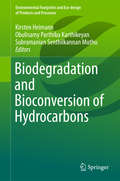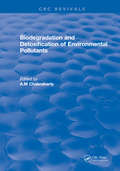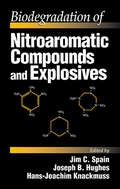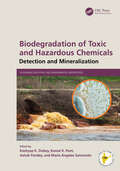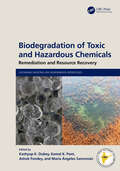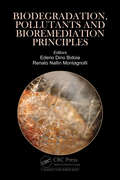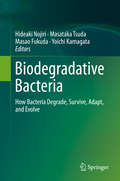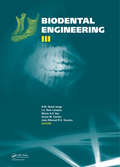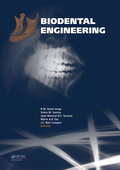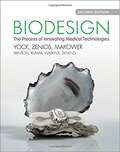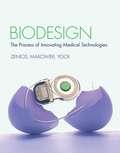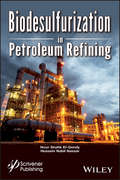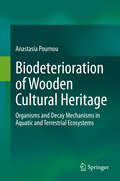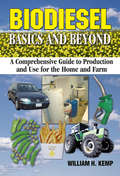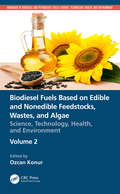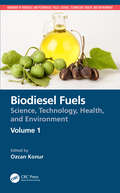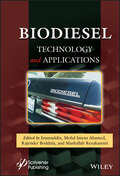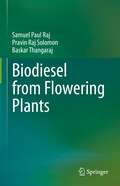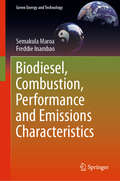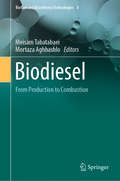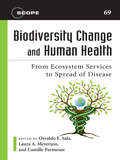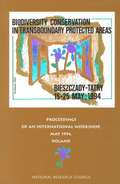- Table View
- List View
Biodegradation and Bioconversion of Hydrocarbons (Environmental Footprints and Eco-design of Products and Processes)
by Subramanian Senthilkannan Muthu Obulisamy Parthiba Karthikeyan Kirsten HeimannThis book details three main topics: the screening and characterization of hydrocarbons from air, soil and water; technologies in the biodegradation of hydrocarbons; and the bioconversion of hydrocarbons for biofuel/chemicals, as well as recent developments in the remediation of hydrocarbons and their environmental benefits. The first section focuses on screening methods, qualitative and quantitative analysis of hydrocarbons from soil, air and water environments, speciation of hydrocarbons, and natural bioremediation strategies in such environments. The second section examines technologies for removing hydrocarbon contaminants from various environments, especially advanced technologies for the removal of hydrocarbons and in-situ and ex-situ remediation strategies and problems, as well as concrete case studies. The last section, covering the bioconversion of hydrocarbons for biofuel/chemicals, highlights the biochemicals and bioproducts developed from hydrocarbons, with a particular focus on biochemical and chemical technologies used to produce biopolymers, biofuel precursors and commodity chemicals from hydrocarbons.
Biodegradation and Detoxification of Environmental Pollutants
by A.M ChakrabartyThe basic objective of the book is to define and review the recent advances in our understand on the biological mechanisms in the biodegradation and detoxification of various environmental pollutants. The book encompasses recent studies on the mode of detoxication of such mercurial compounds by various microorganisms
Biodegradation and Durability of Materials under the Effect of Microorganisms
by Gennady Zaikov Semenov GumargalievaThis volume in the book series New Concepts in Polymer Science deals with the damaging effects, which microorganisms such as bacteria, fungi, etc. can have on a range of materials in machinery. The book aims to provide theoretical notions about the mechanisms of material damaging by microorganisms under operation conditions as well as to give recom
Biodegradation of Azo Dyes (The Handbook of Environmental Chemistry #9)
by Hatice Atacag ErkurtAzo dyes play an important role as coloring agents in the textile, food, and pharmaceutical industry. Due to the toxicity, mutagenicity and carcinogenicity of azo dyes and their breakdown products, their removal from industrial wastewaters has been an urgent challenge. Promising and cost-effective methods are based on their biodegradation, which is treated in this volume. The topics presented by experts in the field include: the classification of azo dyes; toxicity caused by azo dyes; aerobic and anaerobic azo dye biodegradation mechanisms; the role of bacteria, fungi, algae and their enzymes in biodegradation; the impact of redox mediators on azo dye reduction; the integration of biological with physical and chemical processes; the biotransformation of aromatic amines; reactor modelling for azo dye conversion; the biodegradation of azo dyes by immobilized bacteria and fungi; and factors affecting the complete mineralization of azo dyes.
Biodegradation of Nitroaromatic Compounds and Explosives
by Jim C Joseph B. Hughes Hans-Joachim KnackmussFilled with practical applications and research, Biodegradation of Nitroaromatic Compounds and Explosives presents an international perspective on environmental contamination from explosives. It covers biodegradation strategies for DNT and a wide variety of other nitroaromatic compounds of environmental significance and makes the information access
Biodegradation of Toxic and Hazardous Chemicals: Detection and Mineralization (Sustainable Industrial and Environmental Bioprocesses)
by Ashok Pandey Kashyap K. Dubey Kamal K. Pant María Ángeles SanrománThis reference book discusses the applications of microorganisms as a crucial solution for the sustainable management of toxic pollutants. It describes the microbial remediation of different kinds of pollutants like wastewater, antibiotics, and toxic chemicals. It highlights the technical, scientific, regulatory, safety, and societal impacts of various sustainable biodegradation approaches. The book describes various sensors in environmental pollution monitoring and pollutant detection.KEY FEATURES Provides a deep understanding of the use of sensors in environmental water monitoring and pollutant detection Covers exciting topics like biological upcycling of plastic wastes into value-added chemicals Presents future research needs on biodegradation and scientific challenges in the mitigation of environmental pollutants Brings out the latest themes, such as eco-design study of bio-nanomaterials, bio-nanofilters, and assessment for the treatment of emerging pollutants Reviews the biodegradation of toxicants to improve the quality of water and air and environmental sustainability This book is meant for scientists, ecologists, microbiologists, industry experts, researchers, students, innovators involved in biotechnology research, and policymakers focused on bioremediation.
Biodegradation of Toxic and Hazardous Chemicals: Remediation and Resource Recovery (Sustainable Industrial and Environmental Bioprocesses)
by Ashok Pandey Kashyap K. Dubey Kamal K. Pant María Ángeles SanrománThis timely reference book discusses the biotechnological applications of microorganisms as a crucial solution for the sustainable management of different types of toxic pollutants. It reviews the sustainable biodegradation approach and resource recovery for different kinds of pollutants like plastic wastes, pharmaceutical wastes, pesticides, and textile industry wastes. The book provides an understanding of biotechnology-based interventions toward a zero-waste route. KEY FEATURES Provides a deep understanding of biodegradation of toxic pollutants from industries ranging from textiles to pharmaceuticals Presents novel technologies for the sustainable treatment of environmental pollution Reviews crucial considerations like energy requirements and cost analysis Brings out the latest themes such as the eco-design study of bio-nanomaterials, bio-nanofilters, and assessment for the treatment of emerging pollutants and IoT-based technology Covers the latest research developments in the biodegradation of antibiotics, pesticides, and electronic wastes This book is meant for scientists, ecologists, microbiologists, industry experts, researchers, students, innovators involved in biotechnology research, and policymakers focused on bioremediation.
Biodegradation, Pollutants and Bioremediation Principles
by Ederio Dino BidoiaThis book presents a broad compendium of biodegradation research and discussions on the most up-to-date bioremediation strategies. The most relevant microbiological, biochemical and genetic concepts are presented alongside the fundamentals of bioremediation. The topics include: a wide variety of contaminant impacts evaluation, key methodologies required to measure biodegradation and propose new bioremediation protocols, as well as the handling of microbial communities related to such processes. The selected collaborating authors are renowned for their microbiology expertise and will provide an in-depth reference for students and specialists. The contents provide a valuable source of information for researchers, professionals, and policy makers alike.
Biodegradative Bacteria: How Bacteria Degrade, Survive, Adapt, and Evolve
by Hideaki Nojiri Masataka Tsuda Masao Fukuda Yoichi KamagataBiodegradative Bacteria highlights the novel nature of bacterial cell functions in the field of biodegradation by putting them into three parts: (1) Genetic and genomic systems, (2) Degradative enzyme systems, and (3) Bacterial behavior in natural environmental systems. The first part of the book includes cell functions as degradative machinery, genome systems for effective degradation, and the evolution of degradative systems by mobile genetic elements. The second part deals with the structure, function, evolution, diversity, and application of degradative and related enzymes. The third part presents cell or genomic behaviors of biodegradative bacteria in natural ecosystems. Bacterial metabolic capacity, which plays an important role in the global material cycle, contributes significantly to the buffering capacity for the huge and unintended release of various chemicals. Recently, however, the prosperity and globalization of material civilization has led not only to severe local contamination by hazardous chemicals, but also to continuous increment of contaminant concentrations worldwide. To solve such urgent global issues, bacterial functions that are involved in biodegradation of hazardous chemicals have been analyzed. The term "biodegradative bacteria" refers to those bacteria that have the ability to degrade such xenobiotic (man-made) and/or hazardous chemicals. Analyses of biodegradative bacteria include diverse areas of study, such as genetics, enzymology, genomics, cell physiology, ecology, and evolutionary biology. In other words, the targets investigated in research on biodegradative bacteria include single molecules, single cell systems, bacterial consortia (interaction with surrounding microorganisms), and interaction with surrounding biotic and abiotic materials. Such complexity makes the research on biodegradative bacteria difficult but quite interesting.
Biodental Engineering III
by R.M. Natal Jorge J.C. Reis Campos Mário A.P. Vaz Sónia M. Santos João Manuel R. S. TavaresDentistry is a branch of medicine with its own peculiarities and very diverse areas of action, which means that it can be considered as an interdisciplinary field. Currently the use of new techniques and technologies receives much attention. Biodental Engineering III contains contributions from 13 countries, which were presented at BIODENTAL 2014,
Biodental Engineering: Proceedings Of The 5th International Conference On Biodental Engineering (biodental 2018), June 22-23, 2018, Porto, Portugal
by R.M. Natal Jorge J.C. Reis Campos Sónia M. Santos João Mánuel R.S. Tavares A. P. VazThe aim of Biodental Engineering is to solidify knowledge of bioengineering applied to dentistry. Dentistry is a branch of medicine with its own peculiarities and very diverse areas of action, and in recent years multiple new techniques and technologies have been introduced.This book is a collection of keynote lectures and full papers from Bio
Biodesign: The Process of Innovating Medical Technologies
by Uday N. Kumar Thomas M. Krummel Stefanos Zenios Josh Makower Lyn Denend Todd J. Brinton Paul G. Yock F. T. Jay Watkins Christine Q. KuriharaThis step-by-step guide to medical technology innovation, now in full color, has been rewritten to reflect recent trends of industry globalization and value-conscious healthcare. Written by a team of medical, engineering, and business experts, the authors provide a comprehensive resource that leads students, researchers, and entrepreneurs through a proven process for the identification, invention, and implementation of new solutions. Case studies on innovative products from around the world, successes and failures, practical advice, and end-of-chapter 'Getting Started' sections encourage readers to learn from real projects and apply important lessons to their own work. A wealth of additional material supports the book, including a collection of nearly one hundred videos created for the second edition, active links to external websites, supplementary appendices, and timely updates on the companion website at ebiodesign.org. Readers can access this material quickly, easily, and at the most relevant point in the text from within the ebook.
Biodesign: The Process of Innovating Medical Technologies
by Uday N. Kumar Thomas M. Krummel Paul Yock Stefanos Zenios Josh Makower Lyn Denend Todd J. BrintonRecognize market opportunities, master the design process, and develop business acumen with this 'how-to' guide to medical technology innovation. A three-step, proven approach to the biodesign innovation process - identify, invent, implement - provides a practical formula for innovation. The experiences of hundreds of innovators and companies, in the form of case studies, quotes and practical advice, offer a realistic, action-orientated roadmap for successful biodesign innovation. Real-world examples, end-of-chapter projects, and Getting Started sections guide the reader through each of the key stages of the process and provide a template to create their own new medical devices. Addressing common medical, engineering, and business challenges to develop well-rounded expertise, this book is the complete package for any biodesign entrepreneur. The text is supported by valuable resources, including up-to-date industry changes: found at ebiodesign.org.
Biodesulfurization in Petroleum Refining
by Nour Shafik El-Gendy Hussein Mohamed NassarPetroleum refining and process engineering is constantly changing. No new refineries are being built, but companies all over the world are still expanding or re-purposing huge percentages of their refineries every year, year after year. Rather than building entirely new plants, companies are spending billions of dollars in the research and development of new processes that can save time and money by being more efficient and environmentally safer. Biodesulfurization is one of those processes, and nowhere else it is covered more thoroughly or with more up-to-date research of the new advances than in this new volume from Wiley-Scrivener. <p><p> Crude oil consists of hydrocarbons, along with other minerals and trace elements. Sulfur is the most abundant element after carbon and hydrogen, then comes after it nitrogen, and they usually concentrated in the higher boiling fractions of the crude oil. The presence of sulfur compounds causes the corrosion of refining facilities and catalysts poisoning. Moreover, the presence of nitrogen-compounds directly impacts the refining processes via; poisoning the cracking catalysts and inhibiting the hydrodesulfurization catalysts. In addition, both have bad impacts on the environment, throughout the sulfur and nitrogen oxide emissions. Removing this sulfur and nitrogen from the refining process protects equipment and the environment and creates a more efficient and cost-effective process. <p> Besides the obvious benefits to biodesulfurization, there are new regulations in place within the industry with which companies will, over the next decade or longer, spend literally tens, if not hundreds, of billions of dollars to comply. Whether for the veteran engineer needing to update his or her library, the beginning engineer just learning about biodesulfurization, or even the student in a chemical engineering class, this outstanding new volume is a must-have. Especially it covers also the bioupgrading of crude oil and its fractions, biodenitrogenation technology and application of nanotechnology on both bio-desulfurization and denitrogenation technologies.
Biodeterioration of Wooden Cultural Heritage: Organisms and Decay Mechanisms in Aquatic and Terrestrial Ecosystems
by Anastasia PournouSince prehistoric times and throughout the course of human evolution, wood has been an integral part of all civilizations. Wooden Cultural Heritage can be found worldwide, providing valuable information on the social and economic context of human history. Nonetheless, as a natural cellulosic material, wood shows low resistance to biodeterioration and thus wooden Cultural Heritage often fails to escape decomposition in both aquatic and terrestrial ecosystems. This book provides a comprehensive overview on the biodeterioration of wooden Cultural Heritage and describes the decay mechanisms of key organisms and microorganisms encountered in aquatic and terrestrial ecosystems. Cultural Heritage professionals, researchers and academics may explore within this book the associations between deteriogens, habitats and decay, which will assist them to understand wood biodeterioration and design effective prevention, mitigation and remediation strategies. The book presents case studies around the world to demonstrate the impact of biogenic deterioration on wooden Cultural Heritage and illustrates mechanisms and patterns in order to be a useful handbook of decay diagnosis.Lastly, by adopting a holistic approach to wood decay, basic concepts of wood technology, ecology, and deteriogens' biology are introduced, permitting readers of different scientific backgrounds to easily comprehend wood biodeterioration.
Biodiesel Basics and Beyond
by William H. KempBiodiesel Basics and Beyond aims to separate fact from fiction and to educate potential home, farm, and cooperative manufacturers on the economic production of quality biodiesel from both waste and virgin oil feedstock. The book includes: detailed processes and equipment required to produce biodiesel fuel that meets North American standards how farmers can use excess oilseed as a feedstock for biodiesel production the use of the co-byproduct glycerin in the making of soap a guide to numerous reference materials and a list of supplier data This is North America's definitive guide to responsibly producing biodiesel from waste vegetable oil while minimizing your environmental footprint in the process.
Biodiesel Fuels Based on Edible and Nonedible Feedstocks, Wastes, and Algae: Science, Technology, Health, and Environment (Handbook of Biodiesel and Petrodiesel Fuels)
by Ozcan KonurThis second volume of the Handbook of Biodiesel and Petrodiesel Fuels presents a representative sample of the population papers in the field of feedstock-specific biodiesel fuels. The research on feedstocks for biodiesel fuels has first focused on the edible oils as first-generation biodiesel fuels. However, the public concerns about the competition with foods based on these feedstocks and adverse impact on the ecological diversity and deforestation have resulted in the exploration of nonedible-oil-based biodiesel fuels as second-generation biodiesel fuels in the first instance. Due to the ecological and cost benefits of treating wastes, waste oil-based biodiesel fuels as third-generation biodiesel fuels have emerged. Furthermore, following a series of influential review papers, the research has focused on the algal oil-based biodiesel fuels in recent years. Since the cost of feedstocks in general constitutes 85% of the total biodiesel production costs, the research focused more on improving biomass and lipid productivity in these research fields. Furthermore, since water, CO2, and nutrients (primarily N and P) have been major ingredients for the algal biomass and lipid production, the research has also intensified in the use of wastewaters and flue gases for algal biomass production to reduce the ecological burdens and the production costs. Part 1 presents a representative sample of the population papers in the field of edible oil-based biodiesel fuels covering major research fronts. It covers soybean oil-based biodiesel fuels, palm oil-based biodiesel fuels, and rapeseed oil-based biodiesel fuels as case studies besides an overview paper. Part 2 presents a representative sample of the population papers in the field of nonedible oil-based biodiesel fuels covering major research fronts. It covers Jatropha oil-based biodiesel fuels, polanga oil-based biodiesel fuels, and moringa oil-based biodiesel fuels as case studies besides an overview paper. Part 3 presents a representative sample of the population papers in the field of waste oil-based biodiesel fuels covering major research fronts. It covers wastewater sludge-based biodiesel fuels, waste cooking oil-based biodiesel fuels, and microbial oil-based biodiesel fuels as case studies besides an overview paper. Part 4 presents a representative sample of the population papers in the field of algal oil-based biodiesel fuels covering major research fronts. It covers algal biomass production in general, algal biomass production in wastewaters, algal lipid production, hydrothermal liquefaction of algal biomass, algal lipid extraction, and algal biodiesel production besides an overview paper. This book will be useful to academics and professionals in the fields of Energy Fuels, Chemical Engineering, Physical Chemistry, Biotechnology and Applied Microbiology, Environmental Sciences, and Thermodynamics. Ozcan Konur is both a materials scientist and social scientist by training. He has published around 200 journal papers, book chapters, and conference papers. He has focused on the bioenergy and biofuels in recent years. In 2018, he edited ‘Bioenergy and Biofuels’, that brought together the work of over 30 experts in their respective field. He also edited ‘Handbook of Algal Science, Technology, and Medicine’ with a strong section on the algal biofuels in 2020.
Biodiesel Fuels: Science, Technology, Health, and Environment (Handbook of Biodiesel and Petrodiesel Fuels)
by Ozcan KonurThis first volume of the Handbook of Biodiesel and Petrodiesel Fuels presents a representative sample of the population papers in the field of biodiesel fuels in general. Part I provides an overview of the research field on both biodiesel and petrodiesel fuels highlighting primary and secondary research fronts in these fields. Part II presents a representative sample of the population papers in the field of biooils covering major research fronts. The research on the biooils is a fundamental part of the research on the biodiesel fuels. The research in this field has intensified in recent years with the application of advanced catalytic technologies and nanotechnologies in both production and upgrading of biooils. It covers pyrolysis, hydrothermal liquefaction, and upgrading, and characterization and properties of biooils besides an overview of the research field. Part III presents a representative sample of the population papers in the field of biodiesel fuels in general covering major research fronts. The research in this field has progressed in the lines of production, properties, and emissions of biodiesel fuels. As in the case of biooils, catalysts and additives play a crucial role for the biodiesel fuels. It covers biomass-based catalyst-assisted biodiesel production, enzymatic biodiesel production, additives in biodiesel production, properties, characterization, performance, and policies of biodiesel fuels besides an overview of the research field. Part IV presents a representative sample of the population papers in the field of glycerol, biodiesel waste, covering major research fronts. The research in this field has intensified in recent years with the increasing volume of biodiesel fuels, creating eco-friendly solutions for these wastes of biodiesel fuels for producing valuable biofuels and biochemicals from glycerol. It covers biohydrogen and propanediol production from glycerol as a case study for bioenergy and biochemicals, respectively. This book will be useful to academics and professionals in the fields of Energy Fuels, Chemical Engineering, Physical Chemistry, Biotechnology and Applied Microbiology, Environmental Sciences, and Thermodynamics. Ozcan Konur is both a materials scientist and social scientist by training. He has published around 200 journal papers, book chapters, and conference papers. He has focused on the bioenergy and biofuels in recent years. In 2018, he edited Bioenergy and Biofuels, which brought together the work of over 30 experts in their respective field. He also edited the Handbook of Algal Science, Technology, and Medicine with a strong section on the algal biofuels in 2020.
Biodiesel Technology and Applications
by Inamuddin Mohd Imran Ahamed Rajender Boddula Mashallah RezakazemiEnergy technologies have attracted great attention due to the fast development of sustainable energy. Biodiesel technologies have been identified as the sustainable route through which overdependence on fossil fuels can be reduced. Biodiesel has played a key role in handling the growing challenge of a global climate change policy. Biodiesel is defined as the monoalkyl esters of vegetable oils or animal fats. Biodiesel is a cost-effective, renewable, and sustainable fuel that can be made from vegetable oils and animal fats. Compared to petroleum-based diesel, biodiesel would offer a non-toxicity, biodegradability, improved air quality and positive impact on the environment, energy security, safe-to-handle, store and transport and so on. Biodiesels have been used as a replacement of petroleum diesel in transport vehicles, heavy-duty trucks, locomotives, heat oils, hydrogen production, electricity generators, agriculture, mining, construction, and forestry equipment. This book describes a comprehensive overview, covering a broad range of topics on biodiesel technologies and allied applications. Chapters cover history, properties, resources, fabrication methods, parameters, formulations, reactors, catalysis, transformations, analysis, in situ spectroscopies, key issues and applications of biodiesel technology. It also includes biodiesel methods, extraction strategies, biowaste utilization, oleochemical resources, non-edible feedstocks, heterogeneous catalysts, patents, and case-studies. Progress, challenges, future directions, and state-of-the-art biodiesel commercial technologies are discussed in detail. This book is an invaluable resource guide for professionals, faculty, students, chemical engineers, biotechnologists, and environmentalists in these research and development areas.
Biodiesel from Flowering Plants
by Samuel Paul Raj Pravin Raj Solomon Baskar ThangarajThis book offers an exhaustive coverage of process modifications in biodiesel production from oil drawn from 84 oleaginous plant species occurring in all parts of the world, thereby enlisting the scope and potential of many new and non-conventionally obscure plant sources. Biodiesel, now prepared from major vegetable oils, has become a compulsion to offset the dwindling reserve of petro-diesel, which naturally intrudes into the cooking oil demand. This has necessitated search for new sources. The book consolidates the biodiesel production from oils being extracted from conventional plants and also from a plethora of new and non-conventional plants along with their habit and habitats, history of biodiesel’s invention, explanation on species-wise biodiesel process variables, catalytic inclusions, global standards, fuel properties varying with species, blending benefits, cost effectiveness, shelf life, ignition characteristics, fuel consumption and engine performances with eco-friendly exhaust. This book is of immense use to teachers, researchers, scientists of climatology and carbon footprint, energy consultants, fuel chemists, students of agriculture and forestry, automobile engineering, industrial chemistry, environmental sciences and policy makers or anyone who wishes to scale up the biodiesel industry.
Biodiesel, Combustion, Performance and Emissions Characteristics (Green Energy and Technology)
by Semakula Maroa Freddie InambaoThis book focuses on biodiesel combustion, including biodiesel performance, emissions and control. It brings together a range of international research in combustion studies in order to offer a comprehensive resource for researchers, students and academics alike. The book begins with an introduction to biodiesel combustion, followed by a discussion of NOx formation routes. It then addresses biodiesel production processes and oil feedstocks in detail, discusses the physiochemical properties of biodiesel, and explores the benefits and drawbacks of these properties. Factors influencing the formation of emissions, including NOx emissions, are also dealt with thoroughly. Lastly, the book discusses the mechanisms of pollution and different approaches used to reduce pollutants in connection with biodiesel. Each approach is considered in detail, and diagrams are provided to illustrate the points in line with industry standard control mechanisms.
Biodiesel: Assessment of Environmental Impact in Producing and Using Chains
by Bhaskar Singh Armen B. AvagyanAir pollution policy is closely connected with climate change, public health, energy, transport, trade, and agriculture, and generally speaking, the Earth has been pushed to the brink and the damage is becoming increasingly obvious. The transport sector remains a foremost source of air pollutants – a fact that has stimulated the production of biofuels. This book focuses on the biodiesel industry, and proposes a modification of the entire manufacturing chain that would pave the way for further improvements. Oil derived from oilseed plantations/crops is the most commonly used feedstock for the production of biodiesel. At the same time, the UK’s Royal Academy of Engineering and 178 scientists in the Netherlands have determined that some biofuels, such as diesel produced from food crops, have led to more emissions than those produced by fossil fuels. Accordingly, this book re-evaluates the full cycle of biodiesel production in order to help find optimal solutions. It confirms that the production and use of fertilizers for the cultivation of crop feedstocks generate considerably more GHG emissions compared to the mitigation achieved by using biodiesel. To address this fertilization challenge, projecting future biofuel development requires a scenario in which producers shift to an organic agriculture approach that includes the use of microalgae. Among advanced biofuels, algae’s advantages as a feedstock include the highest conversion of solar energy, and the ability to absorb CO2 and pollutants; as such, it is the better choice for future fuels. With regard to the question of why algae’s benefits have not been capitalized on for biofuel production, our analyses indicate that the sole main barrier to realizing algae’s biofuel potential is ineffective international and governmental policies, which create difficulties in reconciling the goals of economic development and environmental protection.
Biodiesel: From Production to Combustion (Biofuel and Biorefinery Technologies #8)
by Meisam Tabatabaei Mortaza AghbashloThis book presents in-depth information on the state of the art of global biodiesel production and investigates its impact on climate change. Subsequently, it comprehensively discusses biodiesel production in terms of production systems (reactor technologies) as well as biodiesel purification and upgrading technologies. Moreover, the book reviews essential parameters in biodiesel production systems as well as major principles of operation, process control, and trouble-shooting in these systems. Conventional and emerging applications of biodiesel by-products with a view to further economize biodiesel production are also scrutinized. Separate chapters are dedicated to economic risk analysis and critical comparison of biodiesel production systems as well as techno-economical aspects of biodiesel plants. The book also thoroughly investigates the important aspects of biodiesel production and combustion by taking advantage of advanced sustainability analysis tools including life cycle assessment (LCA) and exergy techniques. In closing, the application of Omics technologies in biodiesel production is presented and discussed. This book is relevant to anyone with an interest in renewable, more sustainable fuel and energy solutions.
Biodiversity Change and Human Health: From Ecosystem Services to Spread of Disease (SCOPE Series #69)
by Osvaldo E. Sala Camille Parmesan Laura A. MeyersonBiodiversity Change and Human Health brings together leading experts from the natural science and social science realms as well as the medical community to explore the explicit linkages between human-driven alterations of biodiversity and documented impacts of those changes on human health. The book utilizes multidisciplinary approaches to explore and address the complex interplay between natural biodiversity and human health and well-being. The five parts examine health trade-offs between competing uses of biodiversity (highlighting synergistic situations in which conservation of natural biodiversity actually promotes human health and well-being); relationships between biodiversity and quality of life that have developed over ecological and evolutionary time; the effects of changing biodiversity on provisioning of ecosystem services, and how they have affected human health; the role of biodiversity in the spread of infectious disease; native biodiversity as a resource for traditional and modern medicine Biodiversity Change and Human Health synthesizes our current understanding and identifies major gaps in knowledge as it places all aspects of biodiversity and health interactions within a common framework. Contributors explore potential points of crossover among disciplines (both in ways of thinking and of specific methodologies) that could ultimately expand opportunities for humans to both live sustainably and enjoy a desirable quality of life.
Biodiversity Conservation In Transboundary Protected Areas: Proceedings of an International Workshop Bieszczady and Tatra National Parks, Poland May 15-25, 1994
by National Research Council Staff Alicja Breymeyer Reginald NobleRecognizing the increasing rate of species loss on a global scale and that neither pollution nor ecosystems respects political boundaries, cooperation on many different levels is required to conserve biodiversity. This volume uses four protected areas that Poland shares with its neighbors as case studies to explore opportunities to integrate science and management in transboundary protected areas in Central Europe for the conservation of biodiversity. Specific topics include biodiversity conservation theories and strategies, problems of wildlife management, and impacts of tourism and recreational use on protected areas.
